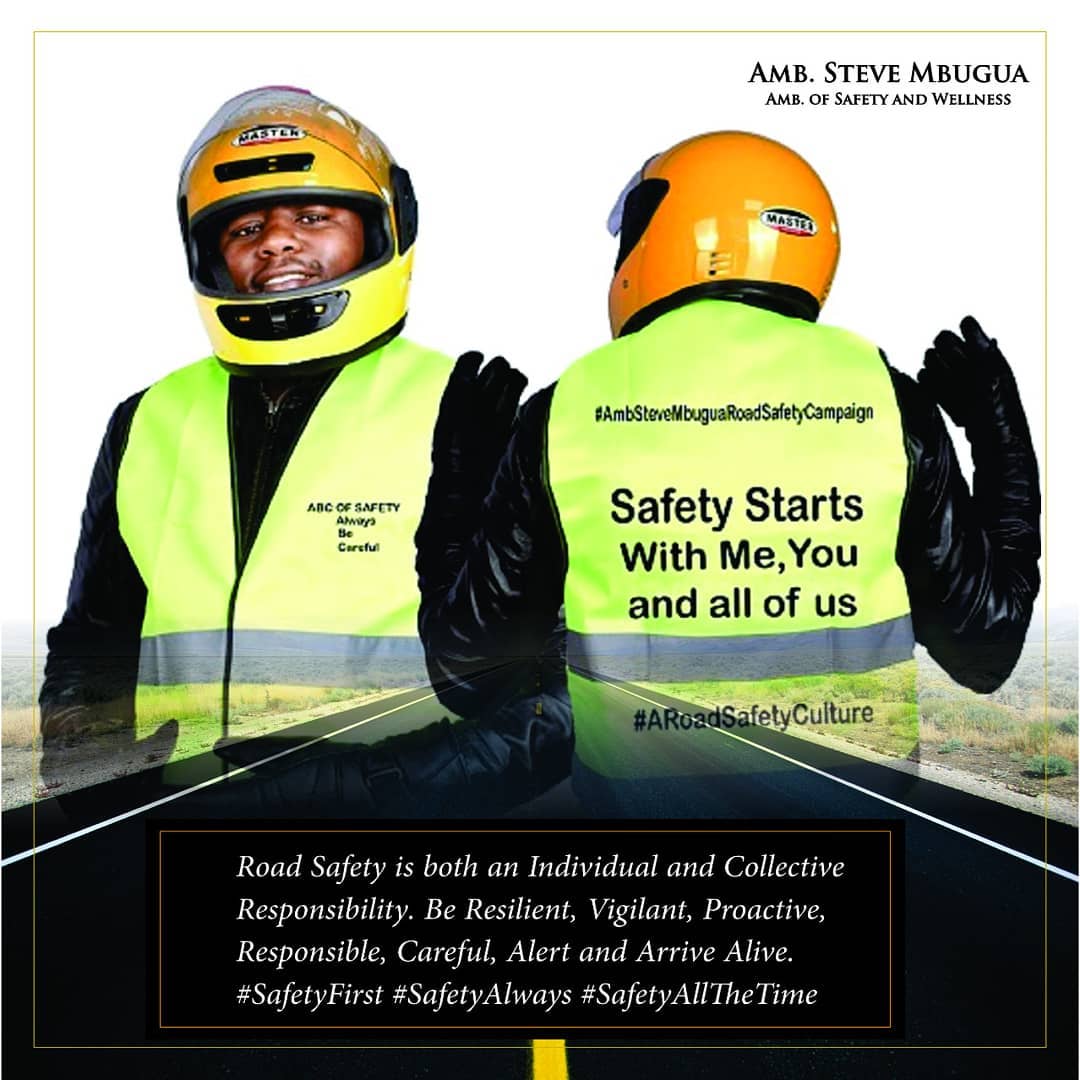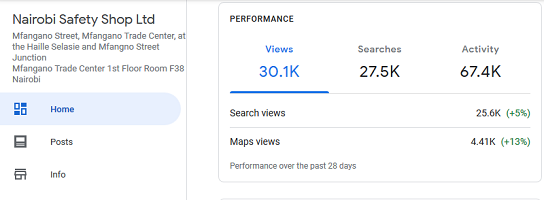As An Ambassador Of safety my mission is to help build a culture of Safety and one of the ways I do it is through provision of quality and appropriate Safety Equipment through my Company Nairobi Safety Shop which is the largest one stop Safety shop in the region with alot of branches around.
Personal Protective Equipment (PPE) is crucial for safeguarding workers from potential hazards in the workplace. PPE includes various devices and clothing designed to protect employees from injury or illness resulting from exposure to hazardous conditions. This comprehensive overview covers the types, selection, usage, maintenance, and training related to PPE.
1. Types of Personal Protective Equipment (PPE)
1.1 Head Protection
Types:
• Hard Hats: Protect against impacts from falling objects, electrical shocks, and collisions. Commonly used in construction, manufacturing, and other industries with overhead hazards.
• Helmets: Specialized headgear for specific tasks, such as climbing or working with heavy equipment. Helmets often include additional features like face shields or earmuffs.
Detailed Explanation:
• Hard Hats: Made from durable materials like polycarbonate or fiberglass, designed to absorb and dissipate impact forces. Hard hats should fit snugly and be worn at all times in areas where overhead hazards are present.
• Helmets: Offer additional protection beyond standard hard hats. For example, climbing helmets are designed to withstand impacts from falls or falling objects in high-altitude environments.
1.2 Eye and Face Protection
Types:
• Safety Glasses: Protect against flying particles, dust, and impact. They come in various styles, including those with side shields for additional protection.
• Goggles: Provide a tight seal around the eyes to protect against chemical splashes, dust, and particles. Used in environments where safety glasses may not provide adequate protection.
• Face Shields: Cover the entire face to protect against splashes, impacts, and high-intensity light. Often used in conjunction with safety glasses or goggles.
Detailed Explanation:
• Safety Glasses: Made from impact-resistant materials like polycarbonate. They are essential for tasks such as grinding, cutting, or working in areas with airborne particles.
• Goggles: Feature a flexible, padded seal that conforms to the face, providing full coverage and protection from chemicals and debris.
• Face Shields: Provide additional protection for the face and neck. They are used in environments with risks such as molten metal splashes or chemical exposures.
1.3 Hearing Protection
Types:
• Earplugs: Inserted into the ear canal to reduce noise exposure. Available in disposable, reusable, and custom-fit varieties.
• Earmuffs: Cover the outer ear and provide noise reduction. Often used in environments with high noise levels, such as construction sites or manufacturing facilities.
Detailed Explanation:
• Earplugs: Provide protection by blocking sound waves from entering the ear canal. They are typically made from foam, silicone, or other flexible materials and are designed for comfort and effectiveness.
• Earmuffs: Feature padded cups that fit over the ears, providing noise reduction through acoustic foam and sound-dampening materials. They are suitable for use in environments with continuous or high-intensity noise.
1.4 Respiratory Protection
Types:
• Disposable Respirators: Single-use masks designed to protect against particulate matter, such as dust or fumes. Commonly used in construction, healthcare, and industrial settings.
• Reusable Respirators: Feature replaceable filters or cartridges to protect against specific hazards, such as gases, vapors, or particles. Used in environments with ongoing or high-level exposures.
• Powered Air-Purifying Respirators (PAPRs): Equipped with a motorized fan that blows filtered air into a facepiece or hood. Provide higher protection and comfort in environments with high concentrations of airborne contaminants.
Detailed Explanation:
• Disposable Respirators: Designed for short-term use and provide protection from specific types of airborne particles. Examples include N95 respirators, which filter out at least 95% of airborne particles.
• Reusable Respirators: Offer customizable protection through interchangeable filters or cartridges. They are suitable for various contaminants and are used for longer-term protection.
• PAPRs: Use a battery-powered fan to deliver clean air into the breathing zone, providing enhanced comfort and protection in high-risk environments.
1.5 Hand Protection
Types:
• Gloves: Available in various materials and designs, including leather, rubber, latex, and cut-resistant types. Gloves protect against cuts, burns, chemicals, and infections.
• Mittens: Provide additional insulation and protection in extreme temperatures or hazardous environments.
Detailed Explanation:
• Gloves: Choose gloves based on the specific hazards, such as heat, chemicals, or sharp objects. Ensure proper fit and material compatibility to maximize protection and dexterity.
• Mittens: Offer greater insulation and protection in extremely cold environments but may reduce dexterity compared to gloves.
1.6 Foot Protection
Types:
• Safety Boots: Feature reinforced toes, puncture-resistant soles, and slip-resistant materials. Protect against heavy objects, sharp materials, and slips or falls.
• Specialized Footwear: Includes boots designed for specific hazards, such as electrical hazards or extreme temperatures.
Detailed Explanation:
• Safety Boots: Constructed with steel or composite toe caps to protect against impacts. Puncture-resistant soles prevent injuries from sharp objects on the ground.
• Specialized Footwear: Designed to meet specific safety standards, such as electrical hazard-rated boots that prevent electrical shocks or insulated boots for cold environments.
1.7 Body Protection
Types:
• Coveralls: Full-body suits that protect against chemicals, contaminants, and extreme temperatures. Often used in industrial or laboratory settings.
• Aprons: Provide protection for the front of the body from spills, splashes, or heat. Commonly used in food processing, welding, or chemical handling.
Detailed Explanation:
• Coveralls: Made from materials that offer protection against a variety of hazards, including chemical spills and extreme temperatures. They should fit properly and provide full coverage.
• Aprons: Provide additional protection to the torso and legs, often worn over other clothing. They are designed to withstand specific types of hazards, such as heat or chemical splashes.
2. Selection of Personal Protective Equipment
2.1 Conduct a Hazard Assessment
Objective: Identify potential hazards in the workplace to determine appropriate PPE.
Steps:
1. Identify Hazards: Assess the work environment and tasks to identify potential risks, such as chemical exposures, physical impacts, or high noise levels.
2. Evaluate Risk: Determine the level of risk associated with each hazard and select PPE that provides adequate protection.
3. Consult Regulations: Ensure PPE selection complies with relevant safety standards and regulations.
Detailed Explanation:
• Hazard Identification: Conduct a thorough assessment of the workplace to identify all potential hazards. Consider both routine and emergency situations.
• Risk Evaluation: Evaluate the severity and likelihood of each hazard to determine the level of protection required.
• Regulatory Compliance: Refer to industry standards and regulations, such as OSHA or ANSI guidelines, to ensure that selected PPE meets legal requirements.
2.2 Choose Appropriate PPE
Objective: Select PPE based on the identified hazards and required protection levels.
Steps:
1. Match PPE to Hazards: Choose PPE that specifically addresses the hazards identified in the risk assessment.
2. Ensure Proper Fit: Select PPE that fits properly to ensure comfort and effectiveness.
3. Verify Standards: Ensure that the PPE meets relevant safety standards and certification requirements.
Detailed Explanation:
• Hazard Matching: For each identified hazard, select PPE that provides the appropriate level of protection. For example, choose respirators with the right filter for airborne contaminants.
• Fit and Comfort: Ensure that PPE is comfortable and fits well to encourage consistent use. Ill-fitting PPE can reduce effectiveness and increase the risk of injury.
• Standards Verification: Check that the PPE complies with safety standards, such as those set by ASTM, ISO, or other relevant organizations.
3. Usage and Maintenance of Personal Protective Equipment
3.1 Proper Usage
Objective: Ensure that PPE is used correctly to provide maximum protection.
Steps:
1. Training: Provide training on the proper use of PPE, including how to wear, adjust, and remove it.
2. Inspect Before Use: Conduct a pre-use inspection to check for damage or wear.
3. Follow Procedures: Adhere to established procedures for donning and doffing PPE.
Detailed Explanation:
• Training: Educate employees on the correct usage of PPE, including instructions for wearing and adjusting. Include information on the limitations of each type of PPE.
• Inspection: Before each use, inspect PPE for signs of damage, such as cracks, tears, or contamination. Do not use damaged PPE.
• Procedures: Follow correct procedures for putting on and taking off PPE to avoid contamination and ensure proper fit.
3.2 Maintenance and Care
Objective: Maintain PPE in good condition to ensure continued effectiveness.
Steps:
1. Clean and Disinfect: Regularly clean and disinfect PPE according to manufacturer instructions.
2. Store Properly: Store PPE in a clean, dry place to prevent damage and contamination.
3. Repair and Replace: Repair or replace PPE as needed to ensure it remains effective.
Detailed Explanation:
• Cleaning and Disinfection: Follow the manufacturer’s guidelines for cleaning PPE to remove contaminants and prevent the buildup of harmful substances.
• Storage: Store PPE away from direct sunlight, chemicals, or extreme temperatures to prevent deterioration.
• Repair and Replacement: Regularly inspect PPE for wear and tear. Replace items that are damaged or no longer provide adequate protection.
4. Training and Education
4.1 PPE Training Programs
Objective: Provide comprehensive training on PPE to ensure proper usage and understanding.
Steps:
1. Develop Training Materials: Create training materials that cover the types of PPE, their uses, and maintenance procedures.
2. Conduct Training Sessions: Hold training sessions for employees, including hands-on demonstrations and practical exercises.
3. Evaluate Understanding: Assess employees’ understanding of PPE through quizzes, demonstrations, and practical assessments.
Detailed Explanation:
• Training Materials: Include information on PPE types, selection criteria, usage instructions, and maintenance practices. Use visual aids and real-life examples.
• Training Sessions: Conduct interactive training sessions to engage employees and provide hands-on experience with PPE. Address common questions and concerns.
• Evaluation: Test employees’ knowledge and skills through practical exercises and assessments. Provide additional training or resources if needed.
4.2 Continuous Improvement
Objective: Continuously improve PPE programs based on feedback and performance.
Steps:
1. Gather Feedback: Collect feedback from employees on PPE effectiveness, comfort, and any issues encountered.
2. Review and Update: Regularly review PPE programs and update procedures based on feedback and changes in regulations or workplace conditions.
3. Monitor Compliance: Monitor PPE usage and compliance to ensure that employees are following safety protocols.
Detailed Explanation:
• Feedback Collection: Use surveys, interviews, and observation to gather employee feedback on PPE. Address any concerns or issues reported.
• Program Review: Periodically review PPE policies and procedures to ensure they remain effective and compliant with current standards.
• Compliance Monitoring: Conduct regular inspections and audits to verify that employees are using PPE correctly and adhering to safety procedures.
Personal Protective Equipment (PPE) is essential for protecting workers from various hazards and ensuring a safe work environment. A thorough understanding of the types of PPE, their proper use, maintenance, and the training required is crucial for maximizing safety and minimizing risks.
By conducting comprehensive hazard assessments, selecting appropriate PPE, ensuring proper usage and maintenance, and providing ongoing training and education, organizations can effectively safeguard their employees and enhance workplace safety. Continuous improvement and adherence to safety standards are key to maintaining a robust PPE program and ensuring long-term protection for all workers.
READ mORE
Large Personal Protective Equipment Store
Safety Equipment Videos
Conducting Safety Training, Seminars and Conferences
Building A Culture Of safety



















